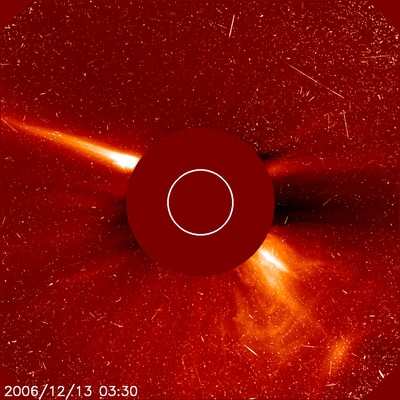New Tool Might Help Preserve Sensitive Spacecraft And
Satellites
 Did you know there is "weather" in
space? Well if you didn't, now you do, and the European Space
Agency (ESA) is working on a tool to monitor and possibly even
predict it.
Did you know there is "weather" in
space? Well if you didn't, now you do, and the European Space
Agency (ESA) is working on a tool to monitor and possibly even
predict it.
Why you say? Because if a satellite encounters high-energy
particles or other space weather phenomena before ground
controllers can take action, on-board electronics could be
disrupted, scientific instruments damaged and, in very rare and
extreme cases, spacecraft may even be lost.
Since early 2005, Space Environment Information System for
Operations (SEISOP), the ESA's space-weather monitoring and
forecasting tool under development at its Space Operations Centre,
has been successfully providing near-real-time space weather
reports for Integral, ESA's gamma-ray space observatory.
Space weather data gathering isn't the sole province of ESA
spacecraft. Some of the data comes from NASA and US National
Oceanic & Atmospheric Administration (NOAA) spacecraft, while
other observations come from numerous ground-based institutes and
facilities. SEISOP is a member of the Space Weather European
Network, or SWENET.

One of the most dangerous space weather phenomena is that
involving solar activity (example of charted data above), which
influences our entire solar system in several ways. Our sun can
generate streams of fast-moving energetic particles and sudden
bursts of damaging X-rays during solar flares. Energetic cosmic
rays from elsewhere in the galaxy also penetrate our solar system.
ESA says space weather accounts for much of the abnormal behavior
and aging for spacecraft and their sensitive scientific
instruments.
Developed in collaboration with the ESA Space Weather
Applications Pilot Project with funding from the Portuguese Task
Force at ESA, SEISOP comprises a database of spacecraft health
records and worldwide space weather observations, combined with
sophisticated software applications that provide reporting,
warning, forecasting and history tracking for the Integral Flight
Control Team.
"Space weather affects spacecraft in many ways. There can be
random lost data, changes in orbit dynamics and reduced quality of
science data. Therefore, real-time updates are essential when
deciding how long to shut down instruments during hazardous
periods," says Alessandro Donati, Head of ESOC's Advanced Mission
Concepts and Technologies office.

SEISOP enables mission controllers to predict when they should
shut down instruments such as star trackers, place systems into
'safe mode' or take other action to protect sensitive on-board
electronics and scientific sensors in the event of violent solar
flare activity like that pictured above from last year.
While some instruments are equipped to automatically shut down
during adverse periods, not all are and bringing an instrument back
into service after an automated shut down is time consuming.
Further, it has until now been difficult to know when radiation had
fallen to safe levels, once an event like a solar flare had taken
place.
According to the ESA, this year SEISOP will enter operational
development aimed at providing all ESA missions with the same vital
space weather updates.
"We expect to start work this year to create the final
operational version. SEISOP can potentially provide warning
services not only within ESA but also to space agencies worldwide,
since space weather can affect any spacecraft," says Donati.
 ANN's Daily Aero-Linx (05.06.25)
ANN's Daily Aero-Linx (05.06.25) ANN's Daily Aero-Term (05.06.25): Ultrahigh Frequency (UHF)
ANN's Daily Aero-Term (05.06.25): Ultrahigh Frequency (UHF) ANN FAQ: Q&A 101
ANN FAQ: Q&A 101 Classic Aero-TV: Virtual Reality Painting--PPG Leverages Technology for Training
Classic Aero-TV: Virtual Reality Painting--PPG Leverages Technology for Training Airborne 05.02.25: Joby Crewed Milestone, Diamond Club, Canadian Pilot Insurance
Airborne 05.02.25: Joby Crewed Milestone, Diamond Club, Canadian Pilot Insurance





